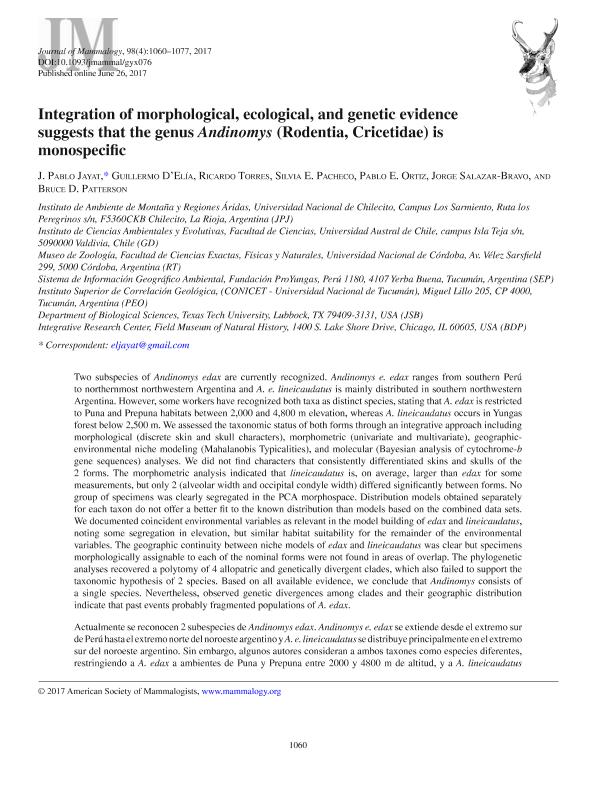Artículo
Integration of morphological, ecological, and genetic evidence suggests that the genus Andinomys (Rodentia, Cricetidae) is monospecific
Jayat, Jorge Pablo ; D' Elía, Guillermo; Torres, Ricardo Marcelo; Pacheco, Silvia Elena
; D' Elía, Guillermo; Torres, Ricardo Marcelo; Pacheco, Silvia Elena ; Ortiz, Pablo Edmundo
; Ortiz, Pablo Edmundo ; Salazar Bravo, Jorge; Patterson, Bruce
; Salazar Bravo, Jorge; Patterson, Bruce
 ; D' Elía, Guillermo; Torres, Ricardo Marcelo; Pacheco, Silvia Elena
; D' Elía, Guillermo; Torres, Ricardo Marcelo; Pacheco, Silvia Elena ; Ortiz, Pablo Edmundo
; Ortiz, Pablo Edmundo ; Salazar Bravo, Jorge; Patterson, Bruce
; Salazar Bravo, Jorge; Patterson, Bruce
Fecha de publicación:
06/2017
Editorial:
Oxford University Press
Revista:
Journal of Mammalogy
ISSN:
0022-2372
Idioma:
Inglés
Tipo de recurso:
Artículo publicado
Clasificación temática:
Resumen
Two subspecies of Andinomys edax are currently recognized. Andinomys e. edax ranges from southern Perú to northernmost northwestern Argentina and A. e. lineicaudatus is mainly distributed in southern northwestern Argentina. However, some workers have recognized both taxa as distinct species, stating that A. edax is restricted to Puna and Prepuna habitats between 2,000 and 4,800 m elevation, whereas A. lineicaudatus occurs in Yungas forest below 2,500 m. We assessed the taxonomic status of both forms through an integrative approach including morphological (discrete skin and skull characters), morphometric (univariate and multivariate), geographicenvironmental niche modeling (Mahalanobis Typicalities), and molecular (Bayesian analysis of cytochrome-b gene sequences) analyses. We did not find characters that consistently differentiated skins and skulls of the 2 forms. The morphometric analysis indicated that lineicaudatus is, on average, larger than edax for some measurements, but only 2 (alveolar width and occipital condyle width) differed significantly between forms. No group of specimens was clearly segregated in the PCA morphospace. Distribution models obtained separately for each taxon do not offer a better fit to the known distribution than models based on the combined data sets. We documented coincident environmental variables as relevant in the model building of edax and lineicaudatus, noting some segregation in elevation, but similar habitat suitability for the remainder of the environmental variables. The geographic continuity between niche models of edax and lineicaudatus was clear but specimens morphologically assignable to each of the nominal forms were not found in areas of overlap. The phylogenetic analyses recovered a polytomy of 4 allopatric and genetically divergent clades, which also failed to support the taxonomic hypothesis of 2 species. Based on all available evidence, we conclude that Andinomys consists of a single species. Nevertheless, observed genetic divergences among clades and their geographic distribution indicate that past events probably fragmented populations of A. edax. Actualmente se reconocen 2 subespecies de Andinomys edax. Andinomys e. edax se extiende desde el extremo sur de Perú hasta el extremo norte del noroeste argentino y A. e. lineicaudatus se distribuye principalmente en el extremo sur del noroeste argentino. Sin embargo, algunos autores consideran a ambos taxones como especies diferentes, restringiendo a A. edax a ambientes de Puna y Prepuna entre 2000 y 4800 m de altitud, y a A. lineicaudatus.
Archivos asociados
Licencia
Identificadores
Colecciones
Articulos(INSUGEO)
Articulos de INST.SUP.DE CORRELACION GEOLOGICA
Articulos de INST.SUP.DE CORRELACION GEOLOGICA
Articulos(SEDE CENTRAL)
Articulos de SEDE CENTRAL
Articulos de SEDE CENTRAL
Citación
Jayat, Jorge Pablo; D' Elía, Guillermo; Torres, Ricardo Marcelo; Pacheco, Silvia Elena; Ortiz, Pablo Edmundo; et al.; Integration of morphological, ecological, and genetic evidence suggests that the genus Andinomys (Rodentia, Cricetidae) is monospecific; Oxford University Press; Journal of Mammalogy; 98; 4; 6-2017; 1060-1077
Compartir
Altmétricas



